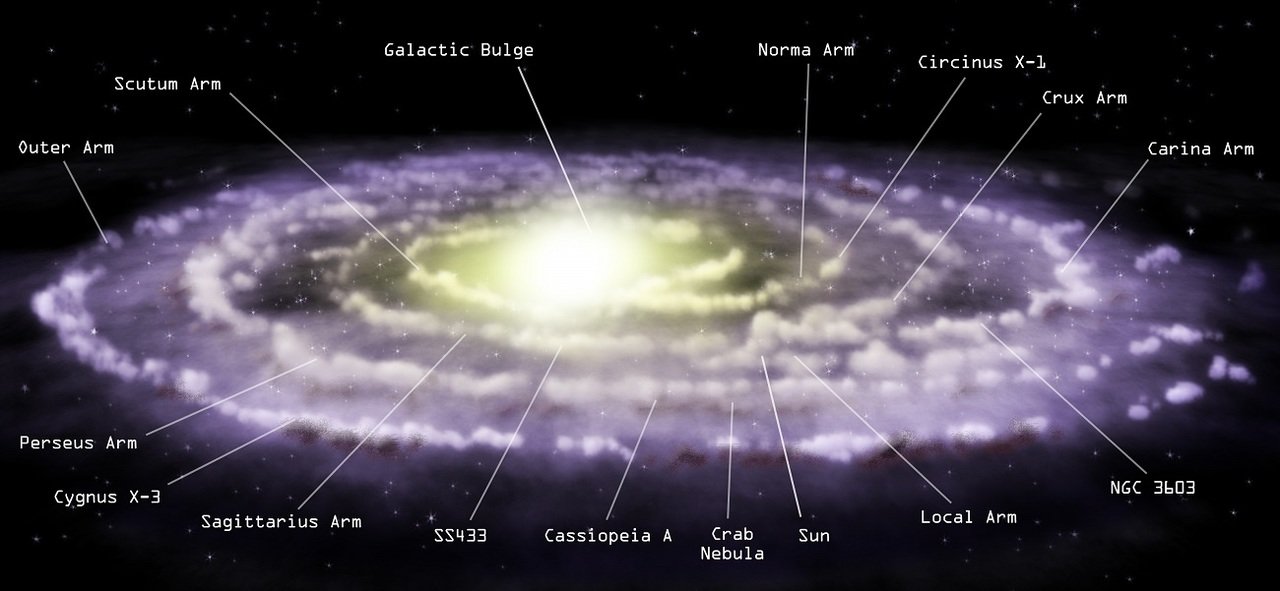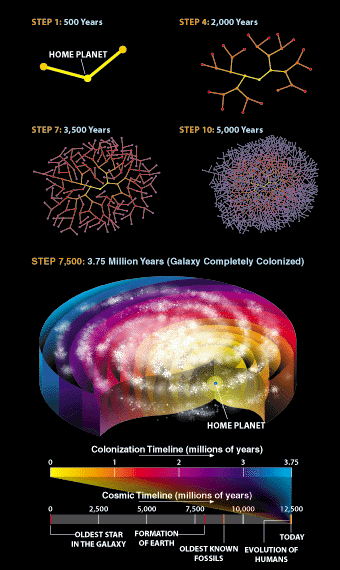Summer of 1950, Los Alamos - Enrico Fermi, Emil Konopinski, Edward Teller, and Herbert York were walking to lunch at Fuller Lodge. Four great minds commence doing what they do best. Bantering about a cartoon they had seen recently, of course. It was about a flying saucer steaming towards little green men (endowed with antennas) carrying the trash cans.
Fermi contemplated how it could a reasonable inference, supported by the sudden reports of flying saucers and disappearances of trash cans at the time. Could saucers travel faster than light?
The four scientists concluded that saucers are fictional, but not before seriously debating the merits of it. With the debate concluded, they picked up lunch, and sat together - a group of about eight.
The flying saucers gave way to usual small talk around meals. Out of the blue, Fermi asked, "But where is everybody?". The entire group burst out laughing. Not just because of the abruptness of the question - but everyone knew he was talking about extraterrestrials!
Thus, the legend of the Fermi Paradox was born. Fermi believed in the existence of extraterrestrials - yet he questioned why we have never met any.

Image: American Institute of Physics
The Fermi Paradox
This is the line of thought examined by Michael Hart.
- The Sun is a young star.
- There are billions of stars in the galaxy that are billions of years
- Some of these stars likely have Earth-like planets which if the Earth is typical may develop intelligent life.
- Presumably some of these civilizations will develop interstellar travel a technology Earth is investigating even now.
- At any practical pace of interstellar travel the galaxy can be completely colonized in a few tens of millions of years.
- According to this line of thinking the Earth should have already been colonized or at least visited
But no convincing evidence of this exists. - Furthermore no confirmed signs of intelligence elsewhere have been spotted either in our galaxy or the more than 80 billion other galaxies of the observable universe.
Hence,
The apparent size and age of the universe suggest that many technologically advanced extraterrestrial civilizations ought to exist. However, this hypothesis seems inconsistent with the lack of observational evidence to support it.
There are many possible explanations for the Fermi Paradox. I'll take you through one such line of thought - but hardly the only one.
The most obvious answer would be - extraterrestrials simply don't exist. We are alone. But let's see why that's highly unlikely.
Abiogenesis
Simply put, abiogenesis is the process by which elements of life form from non-living molecules. At first, the probability of forming a long protein seems to be an extra-astronomical 1 chance in 10400. That's way more than atoms in the Universe!
However, looking closer, abiogenesis is not just random chance. It's a process, where every step is curated by trial and error. Early natural selection, so to speak. Life doesn't just emerge from simple chemicals. From simple chemicals come polymers, followed by replicating polymers, before anything that remotely resembles life.
Given the volume of water in early Earth's oceans, even with a dilute concentration of amino acid, there are trillions of trials taking place. It all adds up - an enormous number of 1031 replicating peptides are likely to evolve within a year.
It's no co-incidence, then, that Life began almost immediately after the Late Heavy Bombardment, once oceans started to emerge.
Pretty much as soon as life is possible, it takes hold.
Life is extraordinarily resilient
Life doesn't even need water, sunlight, or Oxygen! Indeed, there are extremophiles of all kinds, who thrive in conditions that will quickly kill most organisms. Whether it be highly acidic, extremely hot, complete absence of Oxygen - species have evolved to survive everywhere.
But how about the ultimate test - Space itself. Not only do some organisms survive, but they even thrive! Often causing the ISS crew great problems. Though not technically extremophiles, Tardigrades are true superheroes. These tiny animals can survive at absolute zero, vacuum, intense pressures, ionizing radiation - pretty much anything you throw at it.

Image source
So the question is - why ever would an organism from Earth evolve to survive in Space? Surely, there's nothing resembling vacuum on planet Earth. Could they have traveled through Space, to Earth? This idea is called Panspermia, and while unlikely, is certainly impossible. We have pretty surely carried microorganisms to other parts of the Solar System ourselves.
There's little question about it - the Universe is teeming with life. But what about intelligent species capable of interstellar communication?
So the question is - why ever would an organism from Earth evolve to survive in Space?
Life is easy, intelligence is hard
Firstly, we must define intelligence in this context. It is the ability to transmit electromagnetic waves that may be detected by extraterrestrial civilizations as clearly patterned and distinguishable from background noise.
Life on Earth took 4 billion years to achieve that standard, and it took an incredible amount of chance. Given enough time, intelligence will evolve, but the question is - would life survive that long? The Earth has gone through many extinction events - The Great Dying killing off over 90% of all species - and there could be one so cataclysmic that no life survives. Indeed, as I discussed in a previous article, the human species were on the brink of extinction just 75,000 years ago. Had that happened, intelligence could have been postponed by millions of years.
Given intelligence takes time to evolve, just how many intelligent civilizations are there?
The Drake Equation
At an early SETI meeting, Dr. Frank Drake came up with a brilliant equation, to determine the likelihood of intelligent civilizations. This is not a formula but a probabilistic argument, one that should give us an idea of just how probable it is.

N = The number of civilizations in The Milky Way Galaxy whose electromagnetic emissions are detectable.
R* = The rate of formation of stars suitable for the development of intelligent life.
fp = The fraction of those stars with planetary systems.
ne = The number of planets, per solar system, with an environment suitable for life.
fl = The fraction of suitable planets on which life actually appears.
fi = The fraction of life bearing planets on which intelligent life emerges.
fc = The fraction of civilizations that develop a technology that releases detectable signs of their existence into space.
L = The length of time such civilizations release detectable signals into space.
Solving the Drake Equation for the Milky Way galaxy, the original estimates concluded that there are probably between 1,000 and 100 million civilizations.
Today, we have much more information to speculate about most of the parameters.
The equation becomes, N = 7 x 1 x 0.2 x 0.13 x 1 x 0.2 x L.
Or, 0.0364L.
The great unknown is L - how long civilizations last. Using the most pessimistic estimate of L = 420 years, this gets us to 10-15 civilizations. However, we could consider the entire human species as a whole, and bump L a hundred fold. N is probably in the 1,000 range, then.
Considering that there are at least a 100 billion galaxies in the universe, it's fair to say that there are trillions of advanced civilizations across the observable universe.
The Milky Way is vast
Let's start with the Milky Way, a tiny part of the universe. It has a volume of over 12 billion cubic light years. So what if there were 1,000 civilizations? Each one would occupy an "radius of influence" roughly 3,000-5,000 light years across.

Image: Chandra Observatory
Unfortunately, due to the inverse square law, signs of civilization decay to the point of being indistinguishable from background noise within a few light years. Even the most powerful hypothetical electromagnetic signatures by alien civilizations would simply not travel beyond a few hundred light years.
Assuming normal distribution, the probability of two civilizations being within a few light years of each other is over 3 standard deviations, or 1 in thousands / under 0.1%. If we go by the lower figure of 10-15 civilizations within our galaxy, it's practically impossible to run into another intelligent civilization.
The minimum probability of two civilizations being within communication distance is less than 1 in several thousands.
The hypothetical galactic conquerors
The speculation goes like so - An advanced Type II civilization according to Kardashev scale will conquer an entire galaxy within 4 billion years. Of course, there are several problems with this scenario.

Firstly, to get started, building a Type II Dyson sphere - an object that surrounds and harnesses a star's energy - is no easy task. It'll require matter from the entire Solar system, and an amount of energy that can't be generated any other way than an existing Dyson sphere.
In short, if you can build a Dyson sphere - you probably don't need it!
To be realistic, civilizations would have to travel and colonize Space though advanced propulsion methods. 10% the speed of light is entirely possibly, which means a 50,000 year journey to the nearest alien colony. That is, of course, a tall order for a single journey. To travel 50,000 years would mean setting up colonies along the way, each of which could take centuries. Space is a harsh place - it's more than likely many of these colonies will fail and the travelers perish.
However, the hypothetical 50,000 year journey only makes sense once a destination has been found. Of course, this entire exercise is academic, as we won't be communicating with anyone 5,000 light years away anyway!
Finally, there's the possibility that there must be far more advanced civilization, to degrees we cannot comprehend. What we do know is, the more energy a civilization uses, the more at risk it is to run out of resources or go extinct in other ways. This is the Great Filter. Of course, the advantage of space colonization is that the original species would evolve into various different species - evolution on the galactic scale. Nevertheless, one family of species with common ancestry is very unlikely to cast a wide web of influence.
Intergalactic colonization
That is simply not happening, for any civilization. The grandeur of the Universe is inconceivable to us mere humans, but perhaps this incredible video will offer us some perspective.
Across these vast swaths of spacetime, it is pretty much impossible to traverse between galaxies. Looking beyond our Local Group - the nearest galaxies are dozens of millions of light years away. Not to mention, space itself is expanding rapidly, and accelerating.
The obvious exception is when a group of galaxies are in the process of merger - like Milky Way and Andromeda will be in a mere 4 billion years. But at that point it's as good as a single galaxy.
TL;DR
Yes, the Universe is most likely abundant with Life. Intelligent, advanced civilizations, even. It is quite probable that there are over trillion intelligent civilizations across the universe, capable of communication through electromagnetic waves. But the Universe is impossibly massive as well. Very, very rarely would these civilizations ever make contact with one other.
Do check out more great posts on this subject on Steemit by @sauravrungta and @piedpiper.
References:
Calculating the probability of Abiogenesis
Recalling the anecdote
Contemporary discussion on Fermi Paradox
Late Heavy Bombardment co-incides with the beginning of Life
The resiliency of microorganisms in Space
Extremophiles
The Drake Equation
Contemporary update for the Drake Equation
Contemporary numbers for the Drake Equation
Calculations on the span of radio waves
Discussions on Fermi Paradox
Dyson Sphere
And as always, a lot of Wikipedia.

